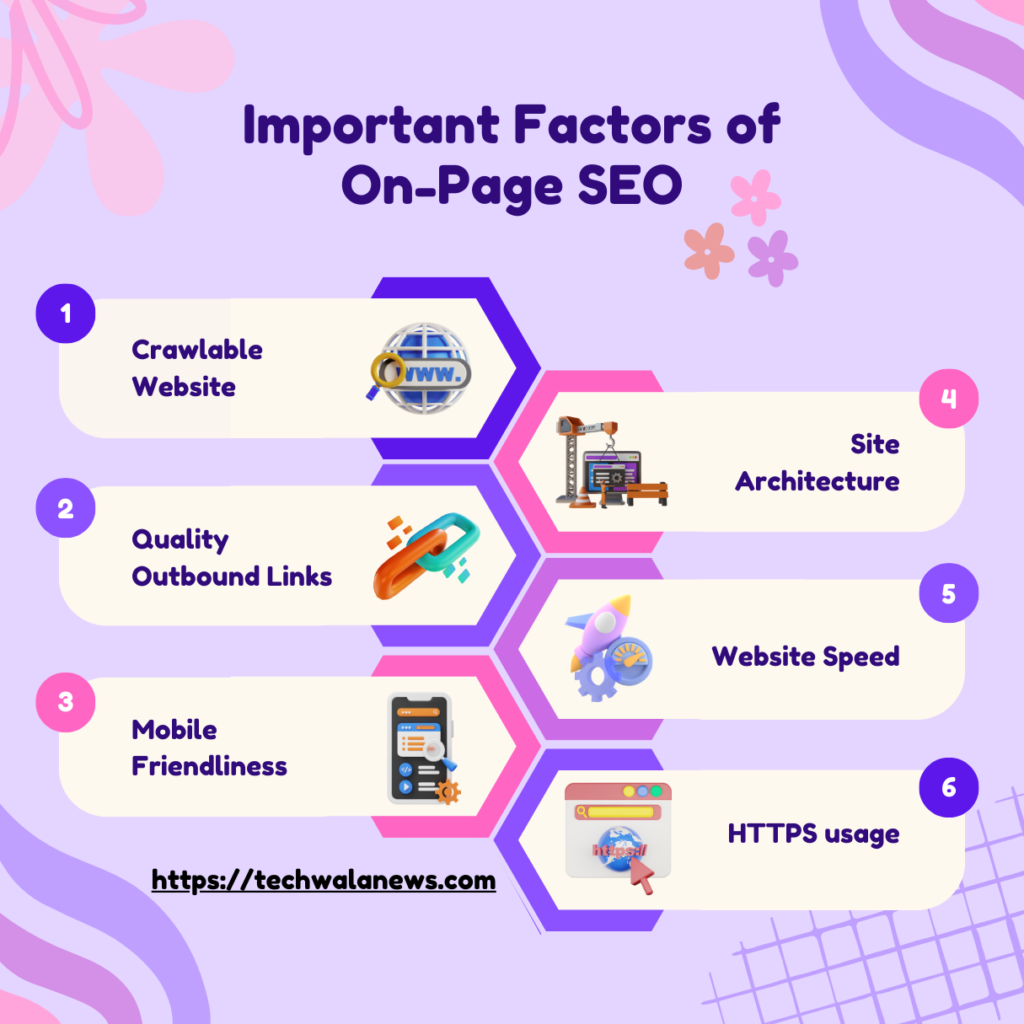
On-page SEO is fine-tuning various website components to help search engines crawl, understand, and rank pages for relevant queries.
While off-page factors like backlinks and brand signals are critical, optimizing on-page elements lays the groundwork for maximizing search visibility.
Beyond the content itself, on-page factors signal a page’s relevance and quality. The website architecture, including site speed, mobile-friendliness, and URL structures, impacts on-page SEO.
On-page SEO matters because:
- It helps search engines find and show your pages to users.
- Higher-ranked pages get more clicks and visitors.
- Good rankings boost your brand’s trustworthiness.
- It enables you to create content that meets your audience’s needs.
- It’s the foundation for other SEO efforts like building links.
This guide explores 13 essential on-page SEO elements, from E-E-A-T and keyword semantics to HTML tags and site architecture.
On-page SEO can be divided into content, HTML, and website architecture.
Here are the content factors you need to consider to maximize your on-site SEO:
1. E-E-A-T
One way Google weights your site is based on E-E-A-T, or experience, expertise, authoritativeness, and trustworthiness.
As highlighted in Google’s Search Quality Rater Guidelines, E-E-A-T evaluates the first-hand experience, subject matter expertise, authority, and trustworthiness demonstrated by a website and its content creators.
Google added experience as a new component, signaling the increasing value placed on content created by those with relevant credentials and direct, real-world experience with the topic. This is especially critical for YMYL (Your Money or Your Life) topics like health, finance, safety, etc.
While Google has only confirmed a few E-E-A-T elements like PageRank and links, it’s generally accepted that factors like author expertise, topical authority, transparency, and hands-on experience play a significant role in E-E-A-T evaluations.
2. Keywords
Creating content that includes the words and phrases your target customers are searching for is essential.
However, with advancements in AI and natural language processing, you’ll need to think beyond individual keywords.
Optimize for:
- Semantically related phrases and topics (entities): For example, if you offer cloud data storage services, related entities could include backup solutions, disaster recovery, data management, etc.
- Contextual meaning and intent: A search for “cloud migration” could have different intents, such as technical how-to guides, pricing/cost info, migration strategies, etc.
- Providing comprehensive answers: Cover related subtopics to address customer journeys fully.
Use keyword research tools to identify relevant entities and related queries around your main topics.
Get started by downloading our ebook on keyword research.
3. SEO Writing
Creating content that prioritizes search engines and converts human visitors to your site is an art.
Writing copy that reads well and adheres to SEO best practices can be challenging unless you’ve done it before.
We have an entire piece dedicated to helping you master the art, but some of the key takeaways include:
- Emphasize readability: Your content should be easily scannable so users can quickly find the information they want.
- Don’t overuse keywords: Keyword stuffing is a technique used by unscrupulous SEO professionals to game the system. Google looks down on sites that overuse keywords. If caught, your page could be demoted in SERPs or removed altogether.
- Keep sentences and paragraphs brief: If you’ve ever clicked on a webpage only to be assaulted by an unbroken wall of text, you know how hard it is to read lengthy pieces of copy. Avoid driving users away by keeping your sentences and paragraphs short.
- Use subheadings: Subheads stand out because of their size, attracting attention from people scanning your page. Use an ample amount of content to guide readers down the page.
- Use bulleted lists: This may feel very meta, but bulleted lists are an excellent way to break information into easily digestible chunks. Use them whenever they make sense.
- Add personal experience: Where relevant, discuss the author’s experience, background, and hands-on knowledge related to the topic to demonstrate experience credentials.
4. Freshness
For rapidly evolving topics, keeping your content fresh and providing new value as you learn more about your audience’s needs is critical.
Google rewards sites that maintain their content rather than letting it become stale or outdated.
Some tips:
- Update content regularly with new information, insights, or angles.
- Fix inaccuracies or outdated information promptly.
- Expand content to cover newly discovered areas of audience interest.
- Consider content exports or opt-in offers for frequently updated content.
5. Visual Assets
Adding pictures, videos, charts, and other eye-catching visuals makes it more attractive for visitors and improves its appearance in search results.
Optimizing images can also help you to gain more visibility through image search and in the SERP image carousel.
To make your content easy to find in text searches and image-based searches, here are some tips:
- Provide contextual information and relevant details in image captions.
- Implement schema markup for images, videos, products, etc., to enhance search visibility.
- Ensure visual assets are high-quality, original, and relevant to the page content.
- For ecommerce sites, provide multiple clear product images from various angles.
As computer vision models advance, search engines will better understand and surface relevant images and videos.
Optimizing for visual search now can help future-proof your content.

